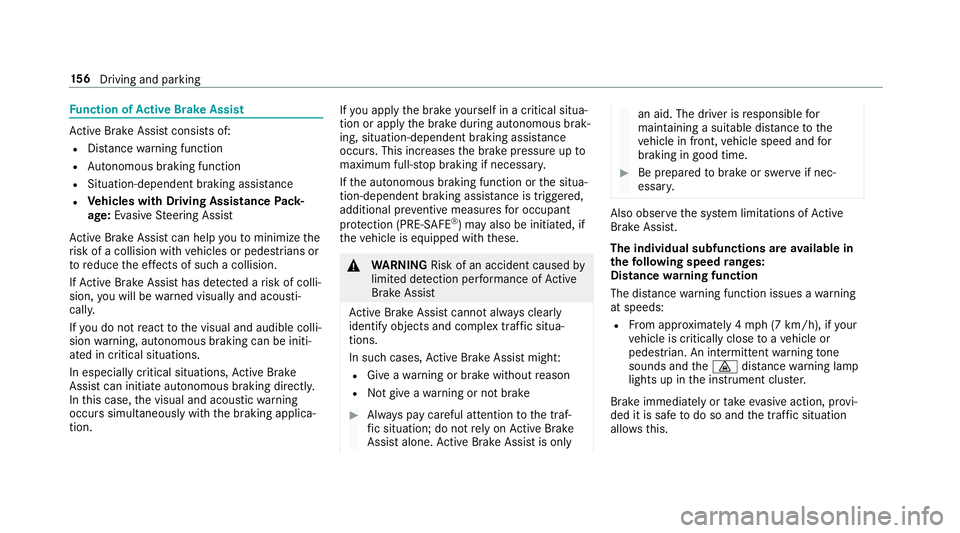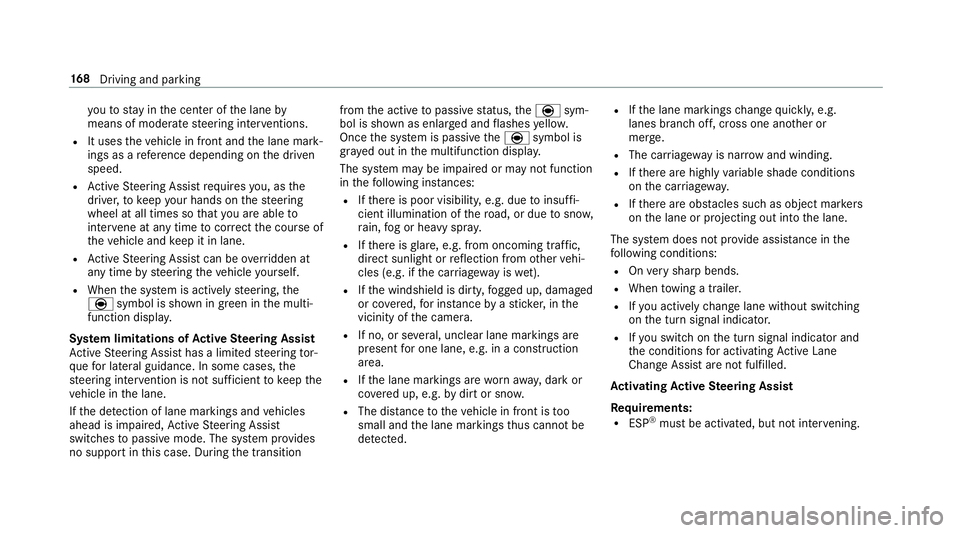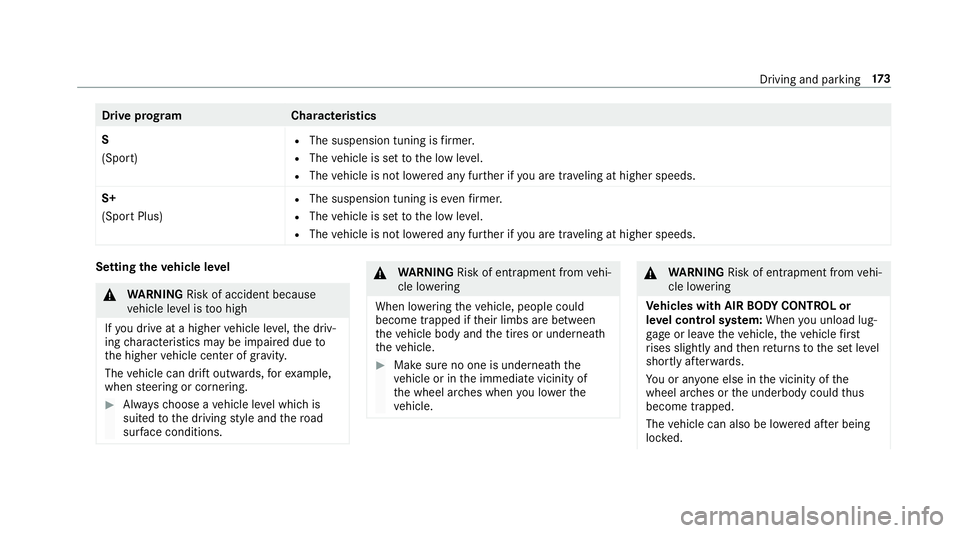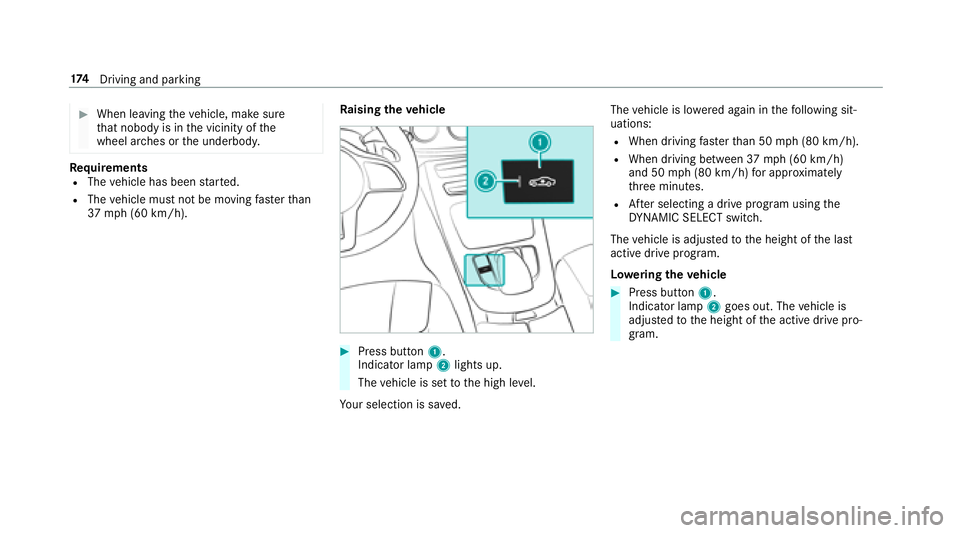2018 MERCEDES-BENZ E-CLASS CABRIOLET light
[x] Cancel search: lightPage 157 of 498

Ifyo udepr essthe brake pedal quickl y,BA S is
acti vated:
RBA S au tomatical lyboosts the brake pres‐
sure.
RBA S can short enthe braking dis tance.
RABS pr events the wheels from locking.
The brakes will function as usual once you
re lease the brake pedal. BAS is deactivated.
Activating/deactivating ESP®(Electronic Sta‐
bility Prog ram)
Multimedia sy stem:
0086�9�H�K�L�F�O�H00CFk �$�V�V�L�V�W�D�Q�F�H00CF�(�6�3
00BBActivate 0073or deacti vate 0053 the function.
ESP
®is deactivated if the00BB ESP®OFFwarn‐
ing lamp lights up continuously in the instrument
clus ter.
Obser vethe information on warning lamps and
display messages which may be shown in the
instrument clus ter.
Fu nctions of ESP®Crosswind Assist
ESP®Crosswind Assist de tects sudden gust s of
side wind and helps the driver tokeep theve hi‐
cle in the lane:
RESP®Crosswind Assist is active at vehicle
speeds between 50 mph(8 0 km/h) and
12 5mp h(2 00 km/h) when driving stra ight
ahead or cornering slightly .
RThevehicle is stabilized bymeans of individ‐
ual brake application on one side.
Fu nction of EBD (Electronic Brake forc e Dis‐
tribution)
EBD is characterized bythefo llowing:
RMonitoring and regulating the brake pressure
on there ar wheels.
RImpr oved driving stability when braking,
especially on bends.
ST EER CONT ROL function
STEER CONTROL helps youby transmitting a
noticeable steering forc eto thesteering wheel in
th e direction requ ired forve hicle stabilization.
This steering recommendation is given part icu‐
larly in thefo llowing situations:
RBo th right wheels or bo thleft wheels are on
a we t or slippe ryroad sur face when you
brake.
RThe vehicle starts toskid.
Sy stem limitations
ST EER CONTROL may be impaire d or may not
function in thefo llowing situations:
RESP®is deactivated.
RESP®is malfunctioning.
RThe steering is malfunctioning.
If ESP
®is malfunctioning, youwill be assis ted
fur ther by the electric po werst eering.
Driving and parking 15
5
Page 158 of 498

Function of Active Brake Assi st
Active Brake Assi stconsist s of:
RDistance warning function
RAu tonomous braking function
RSituation-dependent braking assist ance
RVehicles with Driving Assistance Pack‐
age: Evasi veSteering Assist
Ac tive Brake Assi stcan help youto minimize the
ri sk of a collision with vehicles or pedestrians or
to reduce the ef fects of such a collision.
If Ac tive Brake Assi sthas de tected a risk of colli‐
sion, youwill be warned visually and acousti‐
cally.
If yo udo not react tothe visual and audible colli‐
sion warning, autonomous braking can be initi‐
ated in critical situations.
In especially critical situations, Active Brake
Assi stcan initiate autonomous braking direct ly.
In this case, the visual and acoustic warning
occurs simultaneously with the braking applica‐
tion. If
yo u apply the brake yourself ina critical situa‐
tion or apply the brake during autonomous brak‐
ing, situation-dependent braking assis tance
occurs . This increases the brake pressure up to
maximum full-s top braking if necessar y.
If th e autonomous braking function or the situa‐
tion-dependent braking assis tance is trig gered,
additional pr eventive measures for occupant
pr otection (PRE-SAFE
®) may also be initiated, if
th eve hicle is equipped with these.
0071
WARNING Risk of an accident caused by
limited de tection per form ance of Active
Brake Assi st
Ac tive Brake Assi stcannot al ways clearly
identify objects and complex traffic situa‐
tions.
In such cases,Active Brake Assi stmight:
RGive a warning or brake without reason
RNot give a warning or not brake
00BBAlw ays pay careful attention tothe traf‐
fi c situation; do not rely on Active Brake
Assi stalone. Active Brake Assi stis only
an aid. The driver is responsible for
maintaining a sui table dis tance tothe
ve hicle in front, vehicle speed and for
braking in good time.
00BBBe prepared tobrake or swer veif nec‐
essar y.
Also obser vethe sy stem limitations of Active
Brake Assi st.
The individual subfunctions are available in
th efo llowing speed ranges:
Distance warning function
The dis tance warning function issues a warning
at speeds:
RFr om appr oximately 4 mph (7 km/h), if your
ve hicle is critically close toave hicle or
pedestrian. An intermittent warning tone
sounds and the00BA distance warning lamp
lights up in the instrument clus ter.
Brake immediately or take evasive action, pr ovi‐
ded it is safe todo so and the traf fic situation
allo wsthis.
15 6
Driving and pa rking
Page 161 of 498

0071WARNING Risk of an accident despite
Evasive Steering Assist
Evasive Steering Assist cannot always clearly
identify objects and complex traf fic situa‐
tions.
In addition, thesteering support of Evasive
St eering Assist is general lynot suff icientto
avo id a collision.
In such cases Evasive Steering Assist can:
Rgive an unnecessary warning or pr ovide
assis tance
Rnot give awa rning or not pr ovide assis‐
ta nce
00BBAlw ays pay careful attention tothe traf‐
fi c situation; do not rely on Ev asive
St eering Assist alone.
00BBBe ready tobrake and take evasive
action if necessar y.
00BBPreve ntthe assis tance byactively steer‐
ing in non-critical driving situations.
00BBDrive at an appropriate speed if pedes‐
trians are close tothe path of your vehi‐
cle.
Also obser vethe sy stem limitations of Evasive
St eering Assist.
Sy stem limitations
The sy stem may be impaired or may not function
in thefo llowing situations:
RIn sno w,rain, fog, heavy spr ay, if there is
gl are, in direct sunlight or in greatlyvarying
light conditions.
RIf th e sensors are dirty, mis ted up, damaged
or co vered.
RIfth e sensors malfunction due to otherradar
source inter fere nce, forex ample stro ng radar
re flections in parking garage s.
RIf a loss of tire pressure or a defective tire
has been de tected and displ ayed.
The sy stem may not react cor rectly:
RIn complex traffic situations whe reobjects
cannot always be clearly identified.
RTo pedestrians or vehicles if they mo ve
qu ickly into the sensor de tection range.
RTo pedestrians who are hidden by other
objects.
RIf th e typical outline of a pedestrian cannot
be distinguished from the bac kground.
RIf a pedestrian isnot recognized as such , e.g.
due tospecial clo thing or other objects.
ROn bends with a tight radius.
Setting Active Brake Assi st
Multimedia system:
0086�9�H�K�L�F�O�H00CFk �$�V�V�L�V�W�D�Q�F�H00CF�$�F�W�L�Y�H
�%�U�D�N�H �$�V�V�L�V�W
Ve hicles without Driving Assistance pack‐
age: The settings can be made af terst arting the
ve hicle.
Ve hicles with Driving Assistance pac kage:
The settings can be made when the ignition is
switched on.
00CE It is recommended that you alw ays lea ve
Ac tive Brake Assi stactivated.
Driving and parking 15
9
Page 165 of 498

RActive Dis tance Assist DISTRONIC is acti va‐
te d.
RIfth e driving speed is higher than 45 mph
(70 km/h).
RIf th e driven speed drops below thestored
speed.
RThe sy stem cannot detect a vehicle in there l‐
ev ant area of theove rtaking lane.
Ve hicles with Driving Assistance Package
and Traf fic Sign Assis t:Ac tive Dis tance Assist
DISTRONIC also has theAc tive Speed Limit
Assi stfunction. This function can be configure d
in the multimedia sy stem. If a change in the
speed limit is de tected and Active Dis tance
Assist DISTRONIC is acti vated, Ac tive Dis tance
Assist DISTRONIC assumes this new speed.
The driven speed is adap ted when theve hicle is
le ve l with the tra ffic signs. The speed limit dis‐
play in the Instrument Display is alw ays update d
when theve hicle is le vel with the tra ffic sign.
If Ac tive Dis tance Assist DISTRONIC has been
put into passive modebypressing the accelera‐ to
r pedal, only speed limits which are higher
th an the set speed are adop ted.
Pulling the cruise control le ver will set the dis‐
pla yed speed limit as the speed, pr ovided that:
RAc tive Speed Limit Assi sthas been activated
in the multimedia sy stem and
RAc tive Dis tance Assist DISTRONIC has been
acti vated.
If no speed limit is displa yed when the le ver is
operated, the speed set bythe driver is adop ted.
Drive prog ram
The DYNA MIC SELECT switch allo wsyouto
ch ange the driving style of Active Dis tance
Assist DISTRONIC. Depending on which drive
prog ram is selected, the driving characteristics
can be geared towa rds fuel econom y,comfort or
dynamic per form ance (
→page 138).
Sy stem limitations
Ve hicles with the Driving Assistance Pack‐
age: Active Dis tance Assist DISTRONIC is acti ve
in the 0 mph(0 km/h) to130mp h(210 km/h)
speed range. The sy
stem may be impaired or may not function
in thefo llowing ins tances, forex ample:
RIn snow ,ra in, fog, heavy spr ay, if there is
gl are, in direct sunlight or in greatlyvarying
light conditions.
RThe windshield in the area of the camera is
dirty, mis ted up, damaged or co vered.
RIfth era dar sensors are dirty or co vered.
ROn slippery roads, braking or accelerating
can cause the drive wheels tolose traction
and theve hicle could then skid.
RIn parking garage s,tollst ations or on roads
with steep uphill or downhill gradients.
Do not use Active Dis tance Assist DISTRONIC in
th ese situations.
Tips
Pa yparticu
la rattention in thefo llowing traf fic
situations. In such situations, brake if necessar y.
Ac tive Dis tance Assist DISTRONIC is then deacti‐
va ted:
RWhen cornering, entering and exiting a bend.
RWhen not driving in the center of the lane.
Driving and parking 16
3
Page 169 of 498

00BBReduce 5or increase 6the specified dis‐
ta nce from theve hicle in front.
Pulling away wit hAc tive Di stance Assist
DI STRO NIC
Re quirement: a speed must ha vebeen pr evi‐
ously stored.
00BBRe mo veyour foot from the brake pedal.
00BBBrief lypull the cruise control le verto wa rds
yo u2.
or
00BBAc celerate brie fly.
Yo ur vehicle pulls away and adapts its speed
to that of theve hicle in front. If no vehicle is
de tected in front, your vehicle accelerates to
th e set speed.
Ad opting the speed limit as thesto red speed
Re quirements:
RActive Speed Limit Assi stis activated in the
multimedia sy stem (→page 192).
RAc tive Dis tance Assist DISTRONIC is acti va‐
te d.
RThe sy stem de tects a traf fic sign indicating a
speed limit.
00BBBrie fly pull the cruise control le verto wa rds
yo u2.
The display ed speed limit is adop ted as the
st ored speed. Your vehicle adapts its speed
to that of theve hicle in front, but only up to
th estored speed. If Active Speed Limit Assi st
is activated, any detected changes in the
speed limit are adop tedby the sy stem.
Collision warning
If Ac tive Dis tance Assist DISTRONIC is unable to
suf ficiently decele rate theve hicle in order to
pr eve nt it from approach ingtheve hicle in front,
yo u will be warned visually and acousticall y.An
intermittent warning tone will then sound and
th e dis tance warning lamp will light up in the
instrument clus ter.
00BBBrake immediately in order toinc rease the
dis tance from theve hicle in front.
or
00BBTa ke evasive action pr ovided it is safe todo
so.
Ac tive Steering Assist
Function of Active Steering Assist
Ac tive Steering Assist is only available for
ve hicles with the Driving Assistance Pack‐
age.
RAc tive Steering Assist is operational at
speeds up to130mp h(210 km/h) and helps
Driving and pa rking 16
7
Page 170 of 498

youto stay inthe center of the lane by
means of moderate steering inter ventions.
RIt uses theve hicle in front and the lane mark‐
ings as a refere nce depending on the driven
speed.
RAc tive Steering Assist requ ires you, as the
driver, tokeep your hands onthesteering
wheel at all times so that you are ableto
inter vene at any time tocor rect the course of
th eve hicle and keep it in lane.
RAc tive Steering Assist can be overridden at
any time bysteering theve hicle yourself.
RWhen the sy stem is actively steering, the
è symbol is shown in green in the multi‐
function displa y.
Sy stem limitations of Active Steering Assist
Ac tive Steering Assist has a limited steering tor‐
qu efo r lateral guidance. In some cases, the
st eering inter vention is not suff icienttokeep the
ve hicle in the lane.
If th e de tection of lane markings and vehicles
ahead is impaired, Active Steering Assist
switches topassive mode. The sy stem pr ovides
no support in this case. During the transition from
the active topassive status, theè sym‐
bol is shown as enlar ged and flashes yello w.
Once the sy stem is passive theè symbol is
gr ay ed out in the multifunction displa y.
The sy stem may be impaired or may not function
in the
fo llowin
g ins tances:
RIfth ere is poor visibility, e.g. due toinsuf fi‐
cient illumination of thero ad, or due tosno w,
ra in, fog or heavy spr ay.
RIfth ere is glare, e.g. from oncoming traf fic,
dire ct sunlight or reflection from other vehi‐
cles (e.g. if the car riag ewa yis we t).
RIfth e windshield is dirty, fogged up, damaged
or co vered, for ins tance byast icke r,in the
vicinity of the camera.
RIf no, or se veral, unclear lane markings are
present for one lane, e.g. in a construction
area.
RIf th e lane markings are wornaw ay, dark or
co vered up, e.g. bydirt or sno w.
RThe distance totheve hicle in front is too
small and the lane markings thus cannot be
de tected.
RIfth e lane markings change quickl y,e.g.
lanes branch off, cross one ano ther or
mer ge.
RThe car riag ewa yis nar rowand winding.
RIfth ere are highly variable shade conditions
on the car riag ewa y.
RIfth ere are obs tacles such as object mar kers
on the lane or projecting out into the lane.
The sy stem does not pr ovide assis tance in the
fo llowing conditions:
ROn very sharp bends.
RWhen towing a trailer.
RIfyo u act ively change lane without switch ing
on the turn signal indicator.
RIfyo u switch onthe t urn signal indicator and
th e conditions for activating Active Lane
Change Assi stare not fulfilled.
Ac tivating Active Steering Assist
Requ irements:
RESP®must be activated, but not inter vening.
16 8
Driving and pa rking
Page 175 of 498

Driveprog ramC haracteristics
S
(Sport)
RThe suspension tuning is firm er.
RThe vehicle is set tothe low le vel.
RThe vehicle is not lo wered any fur ther if you are tra veling at higher speeds.
S+
(Sport Plus)
RThe suspension tuning is evenfirm er.
RThe vehicle is set tothe low le vel.
RThe vehicle is not lo wered any fur ther if you are tra veling at higher speeds.
Setting theve hicle le vel
0071
WARNING Risk of accident because
ve hicle le vel is too high
If yo udriv e at a higher vehicle le vel,th e driv‐
ing characteristics may be impaired due to
th e higher vehicle center of gr avity.
The vehicle can drift outwards, forex ample,
when steering or cornering.
00BBAlw aysch oose a vehicle le vel which is
suited tothe driving style and thero ad
sur face conditions.
0071
WARNING Risk of entrapment from vehi‐
cle lo wering
When lo wering theve hicle, people could
become trapped if their limbs are between
th eve hicle body and the tires or underneath
th eve hicle.
00BBMake sure no one is underneath the
ve hicle or in the immediate vicinity of
th e wheel ar ches when you lo werth e
ve hicle.
0071
WARNING Risk of entrapment from vehi‐
cle lo wering
Ve hicles with AIR BODY CONT ROL or
le ve l control sy stem: When you unload lug‐
ga ge or lea vetheve hicle, theve hicle firs t
ri ses slightly and then returns tothe set le vel
shortly af terw ards.
Yo u or an yone else in the vicinity of the
wheel ar ches or the underbody could thus
become trapped.
The vehicle can also be lo wered af ter being
loc ked.
Driving and parking 17
3
Page 176 of 498

00BBWhen leavingtheve hicle, make sure
th at nobody is in the vicinity of the
wheel ar ches or the underbody.
Re quirementsRThe vehicle has been star ted.
RThe vehicle must not be moving fasterthan
37 mph (60 km/h). Ra
ising theve hicle
00BBPress button 1.
Indicato r lamp2lights up.
The vehicle is set tothe high le vel.
Yo ur selection issave d. The
vehicle is lo wered again in thefo llowing sit‐
uations:
RWhen driving fasterthan 50 mph (80 km/h).
RWhen driving between 37mph (60 km/h)
and 50 mph (80 km/h) for app roxima tely
th re e minutes.
RAf ter selecting a drive program using the
DY NA MIC SELECT switch.
The vehicle is adjus tedto the height of the last
active drive program.
Lo weri ngtheve hicle
00BBPress button 1.
Indicato r lamp2goes out. The vehicle is
adjus tedto the height of the active drive pro‐
gram.
17 4
Driving and pa rking